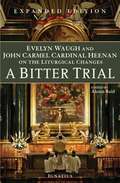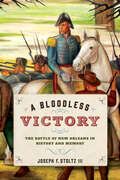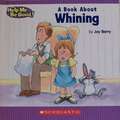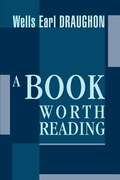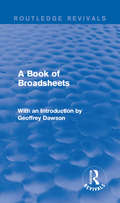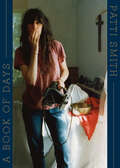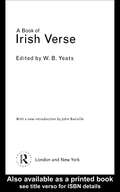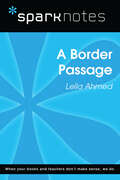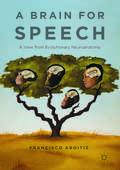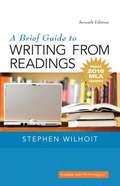- Table View
- List View
A Biosemiotic Ontology: The Philosophy of Giorgio Prodi (Biosemiotics #18)
by Felice CimattiGiorgio Prodi (1928-1987) was an important Italian scientist who developed an original philosophy based on two basic assumptions: 1. life is mainly a semiotic phenomenon; 2. matter is somewhat a semiotic phenomenon.Prodi applies Peirce's cenopythagorean categories to all phenomena of life and matter: Firstness, Secondness, and Thirdness. They are interconnected meaning that the very ontology of the world, according to Prodi, is somewhat semiotic. In fact, when one describes matter as “made of” Firstness and Secondness, this means that matter ‘intrinsically’ implies semiotics (with Thirdness also being present in the world).At the very heart of Prodi’s theory lies a metaphysical hypothesis which is an ambitious theoretical gesture that places Prodi in an awkward position with respect to the customary philosophical tradition. In fact, his own ontology is neither dualistic nor monistic. Such a conclusion is unusual and weird, but much less unusual in present time than it was when it was first introduced. The actual resurgence of various “realisms” make Prodi’s semiotic realism much more interesting than when he first proposed his philosophical approach. What is uncommon, in Prodi perspective, is that he never separated semiotics from the materiality of the world. Prodi does not agree with the “standard” structuralist view of semiosis as an artificial and unnatural activity. On the contrary, Prodi believed semiosis (that is, the interconnection between Firstness, Secondness and Thirdness) lies at the very bottom of life. On one hand, Prodi maintains a strong realist stance; on the other, a realism that includes semiosis as ‘natural’ phenomena. This last view is very unusual because all forms, more or less, of realism exclude semiosis from nature but they frequently “reduce” semiosis to non-semiotic elements. According to Prodi, semiosis is a completely natural phenomenon.
A Bit Is a Bite
by Larry Dane BrimnerA children's book about silent letters in words, like the difference between a bit and a bite.
A Bitter Trial: Evelyn Waugh And John Carmel Cardinal Heenan On The Liturgical Changes
by Evelyn Waugh Alcuin Reid John HeenanEnglish author Evelyn Waugh, most famous for his novel Brideshead Revisited, became a Roman Catholic in 1930. For the last decade of his life, however, Waugh experienced the changes being made to the Church's liturgy to be nothing short of a bitter trial. In John Cardinal Heenan, Waugh found a sympathetic pastor and somewhat of a kindred spirit. <p><p> This volume brings together the personal correspondence between Waugh and Heenan during the 1960s, a trying period for many faithful Catholics. It begins with a 1962 article Waugh wrote for the Spectator followed by a response from then Archbishop Heenan, who at the time was a participant at the Second Vatican Council. These and the other writings included in this book paint a vivid picture of two prominent and loyal English Catholics who lamented the loss of Latin and the rupture of tradition that resulted from Vatican II. <p> In the light of the pontificate of Pope Benedict XVI, many Catholics are looking again at the post-conciliar liturgical changes. To this reform of the reform of the liturgy now underway in the Roman Catholic Church, both Heenan and Waugh have much to contribute.
A Black Woman for President: Shirley Chisholm, Carol Moseley Braun, and Kamala Harris
by Dianna N. Watkins-DickersonThroughout US history, only three Black women—Shirley Chisholm, Carol Moseley Braun, and Kamala Harris—have given successfully recognized bids for the office of president of the United States. In A Black Woman for President, author Dianna N. Watkins-Dickerson uses womanist rhetorical criticism to analyze the presidential announcement speeches of Congresswoman Shirley Chisholm, Ambassador Carol Moseley Braun, and then-Senator Kamala Harris. In close readings of each candidate’s speeches, Watkins-Dickerson defines womanist rhetorical theory and its efficacy for researching Black female voices in the field of communication in general, and the presidential announcement speeches of Black women, specifically. Beginning with Shirley Chisholm’s historic 1972 campaign as the first Black woman to run a viable campaign for the US presidency, the volume analyzes how Chisholm’s speech set a precedent for future generations of Black women in politics by boldly asserting her right to lead, despite the multiple barriers of race and gender. The study then moves to Carol Moseley Braun’s 2004 presidential announcement, exploring how Braun’s speech navigated the intersections of identity, representation, and political ambition during a time when Black women in the Senate were still a rarity. Finally, the analysis culminates with Kamala Harris’s 2020 presidential bid, focusing on how her rhetoric blended elements of Black feminist resistance and national unity in an era of heightened political and racial division. The volume highlights the ways in which Chisholm, Braun, and Harris drew upon their lived experiences and cultural legacies to construct powerful, transformative narratives and argues that their speeches not only expanded the boundaries of political discourse but also reimagined the possibilities for leadership in America. Ultimately, this study provides a rich, interdisciplinary framework for understanding how Black women have reshaped the political landscape through the power of their words.
A Bloodless Victory: The Battle of New Orleans in History and Memory (Johns Hopkins Books On The War Of 1812 Ser.)
by Joseph F. Stoltz IIIThis study of military historiography examines the changing narrative of the Battle of New Orleans through two centuries of commemoration.Once celebrated on par with the Fourth of July, the anniversary of the Battle of New Orleans is no longer a day of reverence for most Americans. The United States’ stunning defeat of the British army on January 8th, 1815, gave rise to the presidency of Andrew Jackson, the Democratic Party, and the legend of Jean Laffite. Yet the battle has not been a national holiday since 1861.Joseph F. Stoltz III explores how generations of Americans have consciously revised, reinterpreted, and reexamined the memory of the conflict to fit the cultural and social needs of their time. Combining archival research with deep analyses of music, literature, theater, and film across two centuries of American popular culture, Stoltz highlights the myriad ways in which politicians, artists, academics, and ordinary people have rewritten the battle’s history.From Andrew Jackson’s presidential campaign to the occupation of New Orleans by the Union Army to the Jim Crow era, the continuing reinterpretations of the battle alienated whole segments of the American population from its memorialization. Thus, a close look at the Battle of New Orleans offers an opportunity to explore not just how events are collectively remembered across generations but also how a society discards memorialization that is no longer necessary or palatable.
A Bloody and Barbarous God: The Metaphysics of Cormac McCarthy
by Petra MundikA Bloody and Barbarous God investigates the relationship between gnosticism, a system of thought that argues that the cosmos is evil and that the human spirit must strive for liberation from manifest existence, and the perennial philosophy, a study of the highest common factor in all esoteric religions, and how these traditions have influenced the later novels of Cormac McCarthy, namely, Blood Meridian, All the Pretty Horses, The Crossing, Cities of the Plain, No Country for Old Men, and The Road. Mundik argues that McCarthy continually strives to evolve an explanatory theodicy throughout his work, and that his novels are, to a lesser or greater extent, concerned with the meaning of human existence in relation to the presence of evil and the nature of the divine.
A Book About Whining
by Joy BerryFrom the book: If you are like most parents, nothing can rankle your nerves more than a whining child--especially when the child is yours! Well, you can rest easy because help is on the way. This book can become your best defense against a whining child. The purpose of this book is to help children understand why they whine and why it is counter-productive for them to do so. In addition, it teaches children more appropriate ways to get the attention they want and need. This is an excellent book for children and parents to read together.
A Book I Value: Selected Marginalia
by Samuel Taylor ColeridgeColeridge is such a celebrity that many who have never read "The Rime of the Ancient Mariner" have a fair idea who he was, and yet the common impression of him is not flattering. He is typically seen as a youthful genius transformed by drugs and philosophy into a tedious sage. It is time for a change of image. A Book I Value offers a one-volume sampling of Coleridge's encyclopedic marginalia, revealing a figure more complex but also more humanly attractive--clever, curious, playful, intense--than the one we are used to.This book makes a convenient introduction to Coleridge's life, the intellectual issues and contemporary concerns that held his attention, and the workings of his mind. The marginalia represent an unintimidating sort of writing that Coleridge famously excelled at (often in books borrowed from friends). "A book, I value," he wrote, "I reason & quarrel with as with myself when I am reasoning."Unlike the complete Marginalia in six volumes arranged alphabetically by author, this representative selection is chronological and footnote-free, with a contextualizing introduction and brief headnotes that outline Coleridge's circumstances year by year and provide essential historical information. Our own cultural taboo against writing in books is slackening in light of new interest in the history of the book. It will be weakened further by the extraordinary and now accessible example of Coleridge, who was a remarkably shrewd but at the same time a remarkably charitable reader.
A Book Worth Reading
by Wells DraughonIs there anything that can be said about the value of a novel, story or film other than that one likes it? If such factors were made known, writers could use them to write books that readers would not only like better but would feel are worth reading. Do the techniques in books on writing produce such novels? Are some books good even though we do not like them? Should we force ourselves to like a book because an English professor or a critic insinuates that only people with good taste like that particular book? Do the "arbiters of good taste" have grounds supporting their claims that the books they like are good? What is the body of knowledge on which such expertise would have to depend? Do they have a right to impose their tastes on students and on the public? (148 words. limit - 150 words/200 words)
A Book of Broadsheets: With an Introduction by Geoffrey Dawson (Routledge Revivals: A Book of Broadsheets)
by VariousThis book, together with A Second Book of Broadsheets makes up an anthology of the 1915 broadsheets distributed by The Times to members of H.M. Forces serving in the trenches of World War I. The volume contains a wide variety of rich literature from before the war and was designed to give soldiers entertainment. It includes extracts from the works of Thomas Hardy, Rudyard Kipling, William Shakespeare, William Wordsworth and Charles Dickens.
A Book of Conquest
by Manan Ahmed AsifManan Ahmed Asif shows that the Chachnama is a sophisticated work of political theory, embedded in both the Indic and Islamic ethos. His social and intellectual history of this text offers an important corrective to the divisions between Muslim and Hindu that so often define Pakistani and Indian politics today.
A Book of Days
by Patti SmithIn 2018, without any plan or agenda for what might happen next, Patti Smith posted her first Instagram photo: her hand with the simple message “Hello Everybody!” Known for shooting with her beloved Land Camera 250, Smith started posting images from her phone including portraits of her kids, her radiator, her boots, and her Abyssinian cat, Cairo. Followers felt an immediate affinity with these miniature windows into Smith’s world, photographs of her daily coffee, the books she’s reading, the graves of beloved heroes—William Blake, Dylan Thomas, Sylvia Plath, Simone Weil, Albert Camus. Over time, a coherent story of a life devoted to art took shape, and more than a million followers responded to Smith’s unique aesthetic in images that chart her passions, devotions, obsessions, and whims. Original to this book are vintage photographs: anniversary pearls, a mother’s keychain, and a husband’s Mosrite guitar. Here, too, are photos from Smith’s archives of life on and off the road, train stations, obscure cafés, a notebook always nearby. In wide-ranging yet intimate daily notations, Smith shares dispatches from her travels around the world. <P><P> With over 365 photographs taking you through a single year, A Book of Days is a new way to experience the expansive mind of the visionary poet, writer, and performer. Hopeful, elegiac, playful—and complete with an introduction by Smith that explores her documentary process—A Book of Days is a timeless offering for deeply uncertain times, an inspirational map of an artist’s life. <p> <b>New York Times Bestseller</b>
A Book of Irish Verse
by W. B. YeatsIn 1895 the thirty-year-old W.B. Yeats, already established as one of Ireland's leading poets and folklorists, published this outstanding collection of Irish verse as part of his campaign to establish a tradition of Irish poetry fit for the dawn of a new age in Ireland's history. This Routledge Classics edition, complete with a specially commissioned introduction by acclaimed writer and critic John Banville, is essential reading for all who appreciate good literature.
A Book of Middle English
by Thorlac Turville-Petre J. A. BurrowThis essential Middle English textbook, now in its third edition, introduces students to the wide range of literature written in England between 1150 and 1400. New, thoroughly revised edition of this essential Middle English textbook. Introduces the language of the time, giving guidance on pronunciation, spelling, grammar, metre, vocabulary and regional dialects. Now includes extracts from ‘Pearl’ and Chaucer’s ‘Troilus and Criseyde’. Bibliographic references have been updated throughout. Each text is accompanied by detailed notes.
A Book of Middle English
by Thorlac Turville-Petre J. A. BurrowThe fourth edition of this essential Middle English textbook introduces students to the wide range of literature written in England between 1150 and 1400. Beginning with an extensive overview of middle English history, grammar, syntax, and pronunciation, the book goes on to examine key middle English texts — including a new extract from Julian of Norwich's Revelation of Divine Love — with helpful notes to direct students to key points within the text. Keeping in mind adopter feedback, this new edition includes a new model translation section with a student workbook and model exercise for classroom use. This new chapter will include sections on 'false friend' words, untranslatable idioms and notes on translating both poetry and prose. The text and references will be fully updated throughout and a foreword dedicated to the late J. A. Burrow will be included.
A Book of Nonsense (Routledge Classics)
by Edward LearFrom the benighted Old Man with a Beard to the erudite Perpendicular Purple Polly, Edward Lear's world is inhabited by a bewildering variety of oddities. One of the world's most loved writers, Lear's verse has delighted whole generations of readers. Here, after 140 years, is the original edition of A Book of Nonsense, from the original publishers. Complete with Lear's own remarkable illustrations, this treasure trove of nonsense is guaranteed to hold readers spellbound for generations more!
A Border Passage (SparkNotes Literature Guide Series)
by SparkNotesA Border Passage (SparkNotes Literature Guide) by Leila Ahmed Making the reading experience fun! Created by Harvard students for students everywhere, SparkNotes is a new breed of study guide: smarter, better, faster.Geared to what today's students need to know, SparkNotes provides:chapter-by-chapter analysis explanations of key themes, motifs, and symbols a review quiz and essay topicsLively and accessible, these guides are perfect for late-night studying and writing papers.
A Bordo: Get Ready for Spanish
by Spanish Course TeamIdeal for near beginners, A bordo takes learners up to the equivalent of GCSE level Spanish. The course is accompanied by three audio-cassettes which include drama and dialogue. Features include:* focus on both Spanish and Latin-American culture* emphasis on communicating in everyday situations* varied exercises, with answer key and progress resumé at the end of each unit.A bordo is the preparatory course for En rumbo, also devised by the Open University Spanish team (see below).
A Boy and a Jaguar
by Catia Chien Alan RabinowitzAlan loves animals, but the great cat house at the Bronx Zoo makes him sad. Why are they all alone in empty cages? Are they being punished? More than anything, he wants to be their champion--their voice--but he stutters uncontrollably.Except when he talks to animals...Then he is fluent. This real-life story with tender illustrations by Catia Chien explores truths not defined by the spoken word. <br><b>2015 Schneider Family Book Award Winner </b>
A Braided Heart: Essays on Writing and Form (Writers On Writing)
by Brenda MillerA Braided Heart provides a friendly, personal, and smart guide to the writing life. It also offers clear and original instruction on craft elements at the forefront of today’s emerging forms in creative nonfiction: from the short-short, to the braided form, to the hermit crab essay. An acknowledged expert in these forms, Brenda Miller gives writers practical advice on how to sustain and invigorate their writing practice, while also encouraging readers to explore their own writing lives. “Brenda Miller writes so beautifully in these lyrical and ‘braided’ essays—personal meditations that take us deep into the miracle of writing itself. Her eye is always alert, her ear wonderfully tuned to the nuances of perception. The art of the essay is alive and well in her hands.” —Jay Parini, author of Borges and Me
A Brain for Speech: A View from Evolutionary Neuroanatomy
by Francisco AboitizThis book discusses evolution of the human brain, the origin of speech and language. It covers past and present perspectives on the contentious issue of the acquisition of the language capacity. Divided into two parts, this insightful work covers several characteristics of the human brain including the language-specific network, the size of the human brain, its lateralization of functions and interhemispheric integration, in particular the phonological loop. Aboitiz argues that it is the phonological loop that allowed us to increase our vocal memory capacity and to generate a shared semantic space that gave rise to modern language. The second part examines the neuroanatomy of the monkey brain, vocal learning birds like parrots, emergent evidence of vocal learning capacities in mammals, mirror neurons, and the ecological and social context in which speech evolved in our early ancestors. This book's interdisciplinary topic will appeal to scholars of psychology, neuroscience, linguistics, biology and history.
A Brief Guide To Agatha Christie
by Nigel CawthorneAgatha Christie?s 80 novels and short-story collections have sold over 2 billion copies in more than 45 languages, more than any other author. When Christie finally killed off her Belgian detective, Hercule Poirot, the year before she herself died, that `detestable, bombastic, tiresome, ego-centric little creep? in Christie?s words, received a full-page obituary in the New York Times, the only fictional character ever to have done so. From her first novel, The Mysterious Affair at Styles, a Poirot mystery, to her last, Sleeping Murder, featuring Miss Marple, Crawford explores Christie?s life and fiction. Cawthorne examines recurring characters, such as Captain Arthur Hastings, Poirot?s Dr Watson; Chief Inspector Japp, his Lestrade, as well as other flat-footed policemen that Poirot outsmarts on his travels; his efficient secretary, Miss Felicity Lemon; another employee, George; and Ariadne Oliver, a humorous caricature of Christie herself. He looks at the writer?s own fascinating: her work as a nurse during the First World War; her strange disappearance after her first husband asked for a divorce; and her exotic expeditions with her second husband, the archaeologist Sir Max Mallowan. He examines the author?s working life ? her inspirations, methods and oeuvre ? and provides biographies of her key characters, their attire, habits and methods, including Poirot?s relationships with women, particularly Countess Vera Rossakoff and Miss Amy Carnaby. In doing so, he sheds light on the genteel world of the country house and the Grand Tour between the wars. He takes a look at the numerous adaptations of Christie?s stories for stage and screen, especially Poirot?s new life in the eponymous long-running and very successful TV series.
A Brief Guide To Agatha Christie (Brief Histories)
by Nigel CawthorneAgatha Christie’s 80 novels and short-story collections have sold over 2 billion copies in more than 45 languages, more than any other author. When Christie finally killed off her Belgian detective, Hercule Poirot, the year before she herself died, that ‘detestable, bombastic, tiresome, ego-centric little creep’ in Christie’s words, received a full-page obituary in the New York Times, the only fictional character ever to have done so. From her first novel, The Mysterious Affair at Styles, a Poirot mystery, to her last, Sleeping Murder, featuring Miss Marple, Crawford explores Christie’s life and fiction. Cawthorne examines recurring characters, such as Captain Arthur Hastings, Poirot’s Dr Watson; Chief Inspector Japp, his Lestrade, as well as other flat-footed policemen that Poirot outsmarts on his travels; his efficient secretary, Miss Felicity Lemon; another employee, George; and Ariadne Oliver, a humorous caricature of Christie herself. He looks at the writer’s own fascinating: her work as a nurse during the First World War; her strange disappearance after her first husband asked for a divorce; and her exotic expeditions with her second husband, the archaeologist Sir Max Mallowan. He examines the author’s working life – her inspirations, methods and oeuvre – and provides biographies of her key characters, their attire, habits and methods, including Poirot’s relationships with women, particularly Countess Vera Rossakoff and Miss Amy Carnaby. In doing so, he sheds light on the genteel world of the country house and the Grand Tour between the wars. He takes a look at the numerous adaptations of Christie’s stories for stage and screen, especially Poirot’s new life in the eponymous long-running and very successful TV series.
A Brief Guide To OZ: 75 Years Going Over The Rainbow (Brief Histories)
by Paul SimpsonWhat if Dorothy Gale wasn't the only person who went to see the Wizard of Oz? MGM's landmark 1939 movie The Wizard of Oz, starring Judy Garland, did not mark the beginning of adventures in Oz. Both before and since, dozens of tales have been told of the Marvellous Land of Oz, and its inhabitants such as the Scarecrow, the Tin Woodman, the Cowardly Lion, the Hungry Tiger and Jack Pumpkinhead. In this fascinating and wide-ranging book, Paul Simpson looks back at the Famous Forty - the original novels by L. Frank Baum and his successors which entranced generations of children with their wonderful world of munchkins, princesses and wicked witches. He examines the many ways in which the stories have been retold in movies - from the silent era to Disney's recent blockbuster Oz the Great and Powerful - and on television, featuring everyone from Tom & Jerry to trades union leaders. On stage, Oz has come to life in the many revivals of The Wizard of Oz musical and the worldwide reign of Elphaba in the smash hit Wicked. Celebrate the 75th anniversary of the world's best-loved film and the whole magical world of Oz with its vampires, muppets, dragons, living statues and so much more.
A Brief Guide To Writing From Readings
by Stephen WilhoitA Brief Guide to Writing from Readings is a clear, process-oriented guide to academic writing. The guide covers the subtleties of rhetorical analysis and argumentation strategies as well as the technical aspects of writing with sources. Students will learn first to examine texts critically and then to clearly, accurately and creatively respond in essay form. In-text tools including summary charts and revision checklists help students tackle source-based essays step by step. Instructors will rely on the guide as a one-stop reference tool; students can apply their learning to any discipline, whether for class work or independent study. <p><p> In the Seventh Edition, in response to student and faculty feedback, Wilhoit includes a new chapter on analyzing readings and composing analytical essays; more coverage of literary analysis and a new short story; eight academic readings; and expanded coverage of how to cite electronic sources in APA and MLA style.


